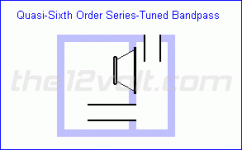seems to work well as it must have in the 1950's - I was pleasantly surprised to have very loud output from BetsyK in the original "Karlsonette" (1954 K12 before the tiny 8K was introduced) - at goodly levels, cone movement couldn't have been more than 1/16" each way - I somehow popped a tinsel lead on my early sample of BetsyK so the fun was short lived
Super10 was loaded into the big 15" driver coupler - K12 are 24.5" tall
the old University fullrange had fs~101Hz and Qts greater than 1.5 but sounded pretty good
I had more fun with the 8" in Karlsonette than my Khorn - bass had better air on the little coupler🙂
to me, Karlson are better than reflex and some blh
Super10 was loaded into the big 15" driver coupler - K12 are 24.5" tall
the old University fullrange had fs~101Hz and Qts greater than 1.5 but sounded pretty good
I had more fun with the 8" in Karlsonette than my Khorn - bass had better air on the little coupler🙂
to me, Karlson are better than reflex and some blh
An externally hosted image should be here but it was not working when we last tested it.
An externally hosted image should be here but it was not working when we last tested it.
An externally hosted image should be here but it was not working when we last tested it.
Last edited:
and I thought the Karlson coupler was a hoax. Last summer my friend built four Karlson cabinets and put two Fostex 207 in one pair, which sounded pretty weak. The other pair got two Schaub - Lorenz 12" full range coaxials, the ones with the two violet plastic cone HF drivers in the middle. That one sounded good, but I have a feeling those Lorenz drivers would sound good in anything.
The driver in the Karlson is very close to the floor, so the listener need clear space between him and the speaker.
The driver in the Karlson is very close to the floor, so the listener need clear space between him and the speaker.
Karlson's a hoax? Far from it. Basically a (rather unusual) variation on the 6th order bandpass; main problem is that nobody ever really worked up the a comprehensive analysis of the physics involved. They do some things very well; others... well, not so well. A 207 probably wouldn't be an ideal unit to experiment with though,
Judging from the impedance curve taked on the Betsy K while mounted in the 1954 Karlsonette, it looks like the typical impedance pattern of two vented chambers in series. In fact, the K Coupler can be seen like two reflex in series, where the cone and the second opening exhausts in a third chamber, that in turn is coupled to the room trough an exponencial opening . If this is correct, most probably the two minimum of cone displacement are shifted in frequency respect to the impedance minimum, as occurs like side effect in the standard DBR that I'm familiarized with.
F3 of the Betsy K mounted in the Karlsonette is probably lower than the lower impedance minimum, and hence the reported low frequency extension.
IMO, of course, and to check whith proper measurement.
F3 of the Betsy K mounted in the Karlsonette is probably lower than the lower impedance minimum, and hence the reported low frequency extension.
IMO, of course, and to check whith proper measurement.
Last edited:
That's basically what a 6th order bandpass is, although on top of that, you have to consider the behavior in detail of the coupler itself, which doesn't act quite like a more typical vent.
Attachments
Last edited:
Could be of interest investigate the efects of other than the exponential shape, for the front opening. I mean on the mid and high frequency range.
I was thinking on the Karlsons like the bass behaviour been cooked in the two rear chambers, and the front chamber and opening more to tame the mid and high frequency. Not exactly a direct radiator type of loudspeaker IMO.
I've heard two K15 sounding in a pub, suspended from the roof, a lot of years ago. The sound was terrific. Hence my strong simpaty for this design.
I was thinking on the Karlsons like the bass behaviour been cooked in the two rear chambers, and the front chamber and opening more to tame the mid and high frequency. Not exactly a direct radiator type of loudspeaker IMO.
I've heard two K15 sounding in a pub, suspended from the roof, a lot of years ago. The sound was terrific. Hence my strong simpaty for this design.
Last edited:
The effect on transient & harmonic behavior tends to be where you see some interesting effects in the Karlson couplers (of this type).
I have downloaded the plans posted by Freddi. The most clearly detailed ever!
But I'm not sure to be able to cut all these angled pieces. And a professional wood worker will cost me a fortune I
I
But I'm not sure to be able to cut all these angled pieces. And a professional wood worker will cost me a fortune
 I
Ithere's only two boards of importance cut at angles: baffle at 28 degrees, and front reflector cut at 45 degrees. I'll try to measure the wings to see if they're radial - its a bit hard to get to as the trim is in the way. The outer shell can be butt joints and cleats will work to hold the internal pieces in place.
"Realistic Reproduction Made Possible By An Exponential Coupler Of Small Dimensions" http://gaviscon2000.fileave.com/Karlson Enclosure.pdf
First Karlson 12 drawn by GregB http://img228.imageshack.us/img228/8316/karlsonetteib7.png
"Realistic Reproduction Made Possible By An Exponential Coupler Of Small Dimensions" http://gaviscon2000.fileave.com/Karlson Enclosure.pdf
First Karlson 12 drawn by GregB http://img228.imageshack.us/img228/8316/karlsonetteib7.png
- Status
- Not open for further replies.
- Home
- Loudspeakers
- Full Range
- Fullrange in classic Karlson couplers
